Do you have a question about the Ariston ERF 290.3 X and is the answer not in the manual?
Ensures proper heat dissipation for compressor and condenser, requiring adequate airflow for optimal performance.
Avoid placing appliance near heat sources like sunlight or ovens to prevent performance issues.
The appliance must be level; use adjustable front feet for stability if the floor is uneven.
Verify voltage compatibility and ensure socket has proper earthing for safe electrical connection.
Confirm the electrical socket can handle the appliance's maximum power load for safe operation.
After delivery, stand appliance upright and wait 3 hours before plugging in for proper functioning.
Control knob for adjusting internal compartment temperatures, with settings from off to coldest.
Specialized boxes designed to preserve food aromas within the refrigerator compartment.
Adjustable door shelves that can be tilted for easier access and storage of bottles and containers.
Door shelves specifically designed for secure storage of various types and sizes of bottles.
Drawers located at the bottom of the refrigerator for storing fruits and vegetables.
A dedicated compartment for storing meat and cheese, often an optional accessory.
Component that collects water during automatic defrosting, channeling it for evaporation.
Internal shelves that can be repositioned to accommodate items of different heights.
Internal illumination to provide visibility within the refrigerator compartment.
Dedicated section within the appliance for the safe storage of frozen food items.
A removable tray designed for making and storing ice cubes within the freezer section.
The primary compartment designated for the freezing of fresh food items.
Guide on using the refrigerator compartment, thermostat control, and understanding the 'cooling area'.
Guidelines for storing various foods, including optimal locations and recommended storage times.
Lists specific food items that should be avoided for storage in the refrigerator compartment.
Install away from heat sources in a well-ventilated room, respecting minimum clearance distances.
Using a temperature setting that is too cold increases energy consumption unnecessarily.
Prevent overfilling to ensure proper cold air circulation and efficient compressor operation.
Minimize door openings to reduce cold air loss and prevent excessive motor work.
Ensure door seals are clean and adhere well to prevent any cold air from escaping.
Allow hot food to cool to ambient temperature before placing it inside the refrigerator.
Defrost the freezer promptly when frost thickness exceeds 15mm for optimal efficiency.
Automatic defrosting process; periodically check and clean the drain hole for proper water flow.
Use provided scraper, remove food, and leave door open for thawing when frost is thick.
Always unplug the appliance from the electrical socket before commencing any cleaning tasks.
Use water and baking soda or neutral soap; avoid abrasive cleaners, bleach, ammonia, or solvents.
Take out removable parts, soak, rinse, and dry them thoroughly before returning them.
Gently clean the rear panel using a vacuum with a long adapter to remove accumulated dust.
Clean and leave doors ajar if not using appliance for a long period to prevent mold and odors.
Unplug appliance, unscrew old lamp, and replace with a new one (maximum 15W).
Troubleshooting steps to identify why the refrigerator is not operating at all.
Checks for inadequate cooling in the refrigerator or freezer compartments.
Troubleshooting steps when food is freezing or becoming too cold in the refrigerator.
Investigating reasons for the compressor motor running non-stop without interruption.
Addressing common noise issues and their potential causes, including installation factors.
Troubleshooting water accumulation at the bottom, often related to drainage system blockage.
Ensures proper heat dissipation for compressor and condenser, requiring adequate airflow for optimal performance.
Avoid placing appliance near heat sources like sunlight or ovens to prevent performance issues.
The appliance must be level; use adjustable front feet for stability if the floor is uneven.
Verify voltage compatibility and ensure socket has proper earthing for safe electrical connection.
Confirm the electrical socket can handle the appliance's maximum power load for safe operation.
After delivery, stand appliance upright and wait 3 hours before plugging in for proper functioning.
Control knob for adjusting internal compartment temperatures, with settings from off to coldest.
Specialized boxes designed to preserve food aromas within the refrigerator compartment.
Adjustable door shelves that can be tilted for easier access and storage of bottles and containers.
Door shelves specifically designed for secure storage of various types and sizes of bottles.
Drawers located at the bottom of the refrigerator for storing fruits and vegetables.
A dedicated compartment for storing meat and cheese, often an optional accessory.
Component that collects water during automatic defrosting, channeling it for evaporation.
Internal shelves that can be repositioned to accommodate items of different heights.
Internal illumination to provide visibility within the refrigerator compartment.
Dedicated section within the appliance for the safe storage of frozen food items.
A removable tray designed for making and storing ice cubes within the freezer section.
The primary compartment designated for the freezing of fresh food items.
Guide on using the refrigerator compartment, thermostat control, and understanding the 'cooling area'.
Guidelines for storing various foods, including optimal locations and recommended storage times.
Lists specific food items that should be avoided for storage in the refrigerator compartment.
Install away from heat sources in a well-ventilated room, respecting minimum clearance distances.
Using a temperature setting that is too cold increases energy consumption unnecessarily.
Prevent overfilling to ensure proper cold air circulation and efficient compressor operation.
Minimize door openings to reduce cold air loss and prevent excessive motor work.
Ensure door seals are clean and adhere well to prevent any cold air from escaping.
Allow hot food to cool to ambient temperature before placing it inside the refrigerator.
Defrost the freezer promptly when frost thickness exceeds 15mm for optimal efficiency.
Automatic defrosting process; periodically check and clean the drain hole for proper water flow.
Use provided scraper, remove food, and leave door open for thawing when frost is thick.
Always unplug the appliance from the electrical socket before commencing any cleaning tasks.
Use water and baking soda or neutral soap; avoid abrasive cleaners, bleach, ammonia, or solvents.
Take out removable parts, soak, rinse, and dry them thoroughly before returning them.
Gently clean the rear panel using a vacuum with a long adapter to remove accumulated dust.
Clean and leave doors ajar if not using appliance for a long period to prevent mold and odors.
Unplug appliance, unscrew old lamp, and replace with a new one (maximum 15W).
Troubleshooting steps to identify why the refrigerator is not operating at all.
Checks for inadequate cooling in the refrigerator or freezer compartments.
Troubleshooting steps when food is freezing or becoming too cold in the refrigerator.
Investigating reasons for the compressor motor running non-stop without interruption.
Addressing common noise issues and their potential causes, including installation factors.
Troubleshooting water accumulation at the bottom, often related to drainage system blockage.
| Installation | Freestanding |
|---|---|
| Total Capacity | 290 L |
| Freezing Capacity | 3 kg/24h |
| Energy Efficiency Class | A+ |
| Energy Class | A+ |
| Climate Class | SN-T |
| Refrigerator Number of shelves | 3 |
| Freezer Number of compartments | 3 |
| Width | 60 cm |
| Weight | 60 kg |
| Color | White |
| Number of Doors | 2 |
| Defrost System | Manual |
| Freezer Net Capacity | 80 l |
| Annual Energy Consumption | 220 kWh/year |
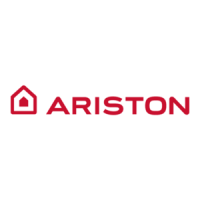
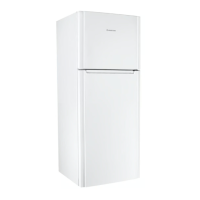
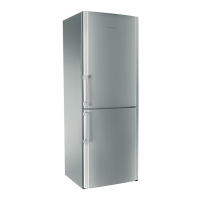
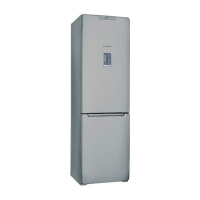
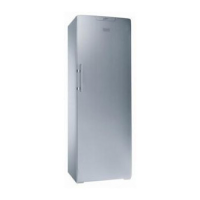
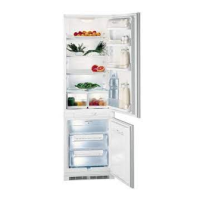

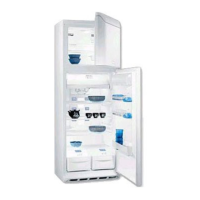

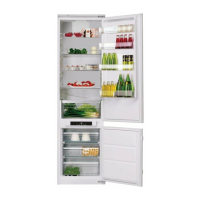

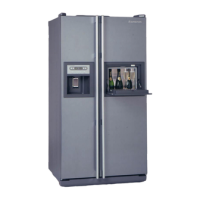
